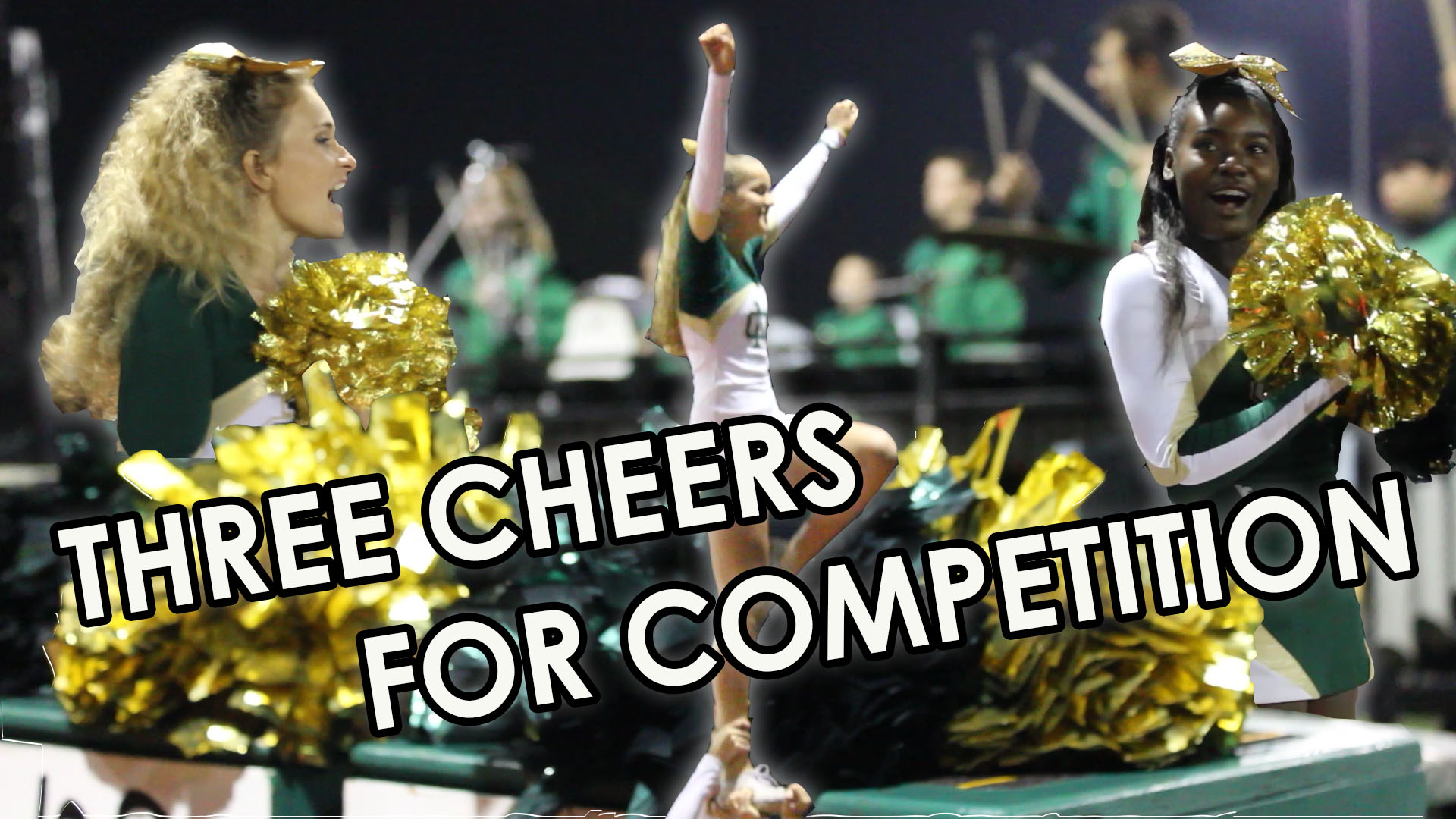
By: Stephanie Haney
With high school competition cheerleading set to become a sport in California in 2017, schools across the state must make game cheer, traditional competition cheerleading, and the new sport of competitive cheer all work together.
A competitive cheerleading model called STUNT may be the answer to complying with soon-to-be required sport regulations once high school competition cheerleading officially becomes a sport in California in less than two years.
After an activity is designated a sport by the California Interscholastic Federation, it is subject to all of the rules and regulations that come along with that status. The rules most relevant to competitive cheer are that federation sports must be completely contained within one season and are allowed only a limited amount of practice time before that season starts.
STUNT, in contrast to cheerleading competitions as they now exist, already fits these federation rules. It is a competitive model for the sport of cheer that incorporates partner stunts, pyramids, basket tosses, jumps and tumbling into a head to head format, pitting one team against another, specific skill versus specific skill.
"[STUNT] is a head to head match," says Travis Neese, former Head Cheer Coach at Loyola Marymount University and current Head Cheer Coach at Mira Costa High School in Manhattan Beach, California. "The [matches] have quarters. There's a beginning and an end so it's very much like football," Neese says.
But unlike football and other federation sports, traditional cheerleading doesn't fit that one-season mold. Game cheer has always covered both fall and winter sports and competition squads work year-round. They usually learn their routines for the next year right after the previous school year ends, then perfect them all summer and compete with those same routines for the entire upcoming school year.
"That's going to be taken away now that we've become a sport," says Maria Cabande, Assistant Cheer Coach at Mira Costa High.
"The practice time will be the biggest issue," says Cabande. "But it's up to the school or the program on how they choose to spend their time, so they can spend it at games and practices or they can spend it at competition practice."
There is an option, though, that might allow California schools to avoid making that tough choice.
Game cheer and traditional large-scale competitions could continue to be considered activities, and therefore avoid having to abide by federation regulations, if USA Cheer, the national governing body for cheerleading, gets its way.
Varsity Spirit Corporation's West Region STUNT Director Lauri Harris says STUNT, created by USA Cheer in 2011, is the sport of cheer. "It's a Title IX compliant sport with skills derived directly from cheerleading," Harris says.
Nearly 100 schools are currently registered in the state of California to participate in the spring season of STUNT, including Mira Costa High School. Last year, just 10 schools were registered in California. At least 11 states are slated to participate in some form this spring.
"We are optimistic that [the federation], in addition to high school athletic directors and principals, will hold up cheerleading for the incredible value it provides," says Harris, "by keeping traditional cheer programs as they are and adding the option of STUNT as an additional female sport at their schools."
If the federation chooses to embrace STUNT as the official sport of cheer in California, it would solve the issue of practice time allotment, says Neese."We [could] still keep the traditional sideline football and basketball cheerleading, community events and pep rallies, and keep taking our sideline routines to those private cheerleading competitions that are traditionally known, but then also be able to go head to head with another cheer program [at STUNT matches]," says Neese.
Hover over the images below to hear what Mira Costa High cheerleaders have to say about competition cheer becoming a sport in California.
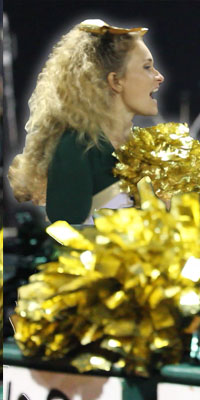
-Nicole Gaines, Varsity Cheerleader
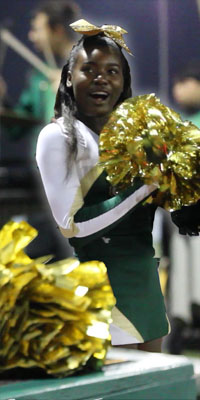
-Dajah Pickering, Junior Varsity Cheerleader
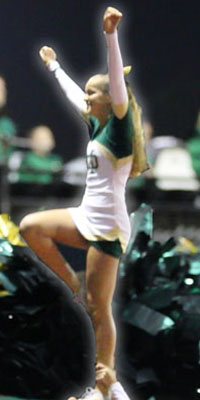
-Rose Darcy, Varsity Cheerleader
In addition to not interfering with traditional competition cheerleading, STUNT offers other advantages.
"It's estimated that only approximately 15 percent of cheer teams actually compete outside of their normal duties of cheering at games, planning pep rallies and going out into the community," says Harris. "And many of those teams might only compete once or twice their entire season."
That was exactly the case for the Mira Costa High squad during the 2014-2015 school year.
"Last year there were some scheduling difficulties so we only ended up going to one competition," says Rose Darcy, Varsity cheerleader in her junior year at Mira Costa. "So that was frustrating, but we did really well."
And doing well in their own right is just as important to these women as pumping up school spirit and leading the crowd.
"Game cheerleading is about supporting our football team. It's not really about us," says Mira Costa senior and Varsity cheerleader Nicole Gaines. "With competition cheer, it's about us. It's our time to shine. We perform, we give it all we've got and we do performance specific to us."
In contrast with traditional competitions, STUNT matches between just two neighboring schools are much simpler to schedule and quicker to travel to since they happen closer to home. That means these matches will provide high school cheerleaders with more opportunities to channel their competitive drive into performance.
That desire to shine is not getting satisfied elsewhere because many high schools cheerleaders do not participate in other sports.
Mira Costa High School cheerleaders Darcy and Gaines say that's because they do not have the time with all of their academic responsibilities, leadership roles and positions as figures promoting school spirit within the community.
This begs the question, does adding a third type of cheerleading to the mix overcrowd an already full plate for busy high school cheerleaders? And does it meet the goals of the legislation bringing all of this discussion about?
Competition Cheer Across The U.S.
Click The States Below For More Information On How That State Approaches The Sport Of Cheer
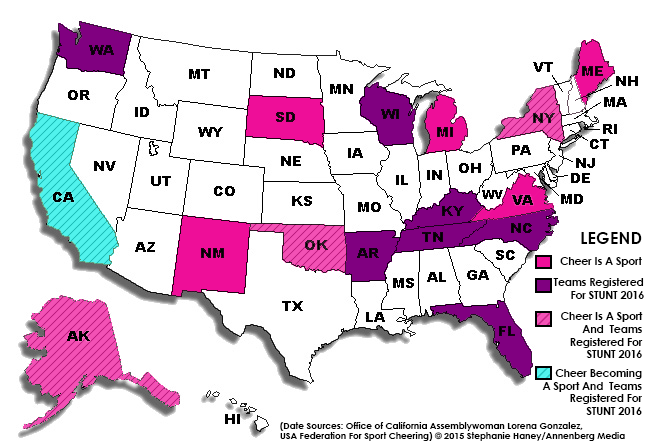
Click The States Below For More Information On How That State Approaches The Sport Of Cheer


Maine DOES recognize cheer as a sport.
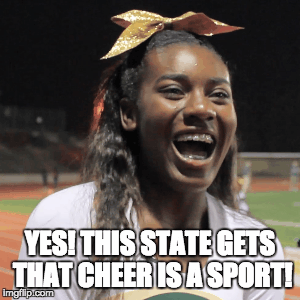
Maine does not currently have teams registered for STUNT in spring 2016.
Virginia DOES recognize cheer as a sport.
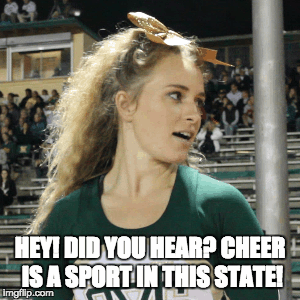
Virginia does not currently have teams registered for STUNT in spring 2016.
Kentucky does NOT recognize cheer as a sport.
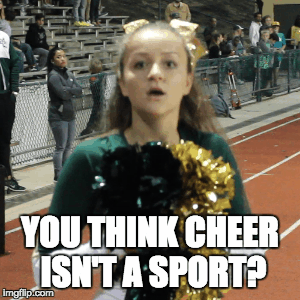
Kentucky is in the process of structuring so it can have a State Championship and USA Cheer hopes to have up to 20 schools playing games during the spring 2016 season of STUNT.
Cheer IS recognized as a sport in Michigan.

Michigan does not currently have teams registered for STUNT in spring 2016.
Wisconsin does NOT recognize cheer as a sport.

Wisconsin had five schools participate in the spring 2015 season of STUNT and will potentially having up to 10 schools playing multiple games in spring 2016.
Arkansas does NOT recognize cheer as a sport.

Four schools will likely play a few STUNT games in conjunction with a collegiate STUNT meet.
South Dakota DOES recognize cheer as a sport.

South Dakota does not currently have teams registered for STUNT in spring 2016.
Cheer IS recognized as a sport in Oklahoma.

Approximately 30 schools will be involved in the upcoming season of STUNT with most playing 6 to 10 games and organizing leagues. There will also be a State Championship this year.
Cheer IS recognized as a sport in New Mexico.

New Mexico does not currently have teams registered for STUNT in spring 2016.
Cheerleading IS a sport in Alaska.

USA Cheer is in talks with Anchorage School District about its eight high schools participating in the spring 2016 STUNT season.
Tennessee does NOT recognize cheer as a sport.
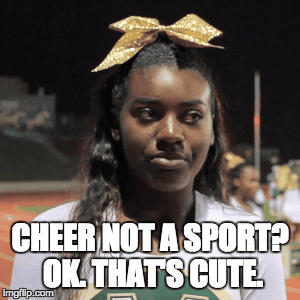
Tennessee will have an organized rollout of high school STUNT this spring. Overall participation numbers are still not known but USA Cheer is hoping for double digits across the state.
Cheerleading is NOT a sport in North Carolina.

There could be up to 14 teams participating in the upcoming season of STUNT. Wake county expects to hold a County Championship. North Carolina has also implemented a Title IX compliant structure.
Cheerleading IS a sport in New York.

New York's Public Schools Athletic League (PSAL) has budgeted for 30 schools to participate in the spring season of STUNT with a city championship. This will be implemented in a Title IX compliant structure. The State of NY, independent of NY City Association's PSAL is looking to have up to 10 schools in the Long Island area playing a series of games.
Cheerleading is NOT a sport in Washington.

Washington has at least eight high schools with teams interested in participating in STUNT in spring 2016.
Cheerleading is NOT a sport in Florida.

USA Cheer expects double-digit participation the spring 2016 season of stunt from Florida high schools.
California will officially recognize cheer as a sport in 2017.

Nearly 100 schools are registered to participate in the spring 2016 season of stunt, some in full structured seasons. California has the fastest growth of STUNT popularity of any state, up from only 10 schools participating last year.
The Act making competition cheer a sport in California goes into effect July 1. It reads, in part, "This bill would require the California Interscholastic Federation... to develop guidelines, procedures, and safety standards for the purpose of classifying competition cheer as an interscholastic sport..."
If the law was written with traditional competition cheerleading in mind, it might not make sense to create a new sport in order to let the status quo continue.
Read more closely with a focus on safety standards, allowing STUNT to be considered the official sport of cheer could potentially allow traditional competition cheer to avoid imposing safety guidelines. The need for stricter safety rules was a major factor in the American Medical Association's decision to consider cheerleading a sport in June 2014.
The association's policy was adopted based on data showing there were nearly 37,000 emergency room visits for cheerleading injuries in the 6-to-22-year-old age group in 2011.
"[Cheerleading] ought to be designated a sport and subjected to safety rules and better supervision," the association says. "The incidence of major cheerleading injuries, including fractures, spinal damage and paralysis, has increased along with the activity's complexity and competitiveness."
At this point, Neese says that very little is set in stone regarding the final shape that the sport of competition cheerleading will take. "Updates have been changing daily from the point when the legislation first came out," Neese says. "It continues to morph."